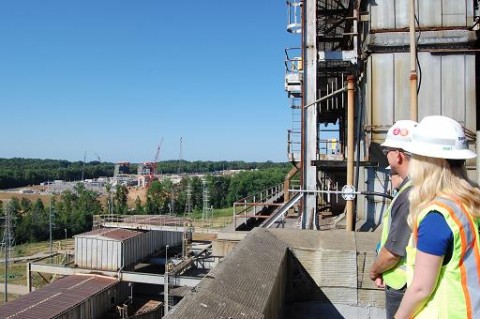By David Meade
For more that sixty years, the W. S. Lee Steam Station was one of the largest structures in the area, rising out of a tranquil area surrounded by trees on one side, and the Saluda River on the other. When it was built in the 1950s, construction on the site brought a boon to the area.
With work on the new Duke Lee Steam Combined Cycle Facility underway and an ash removal project near the main entrance, the original Lee Steam facility that dominated the skyline for more than 60 years, is in the background. Construction of the new power generating facility now dominates the hillside on the six hundred acres tract surrounding the original plant.
And there is a new boon, evidenced by parked vehicles belonging to approximately 400 people working at the site.
Economic Impact
The new facility is being built by Upstate and global construction giant Fluor. More than five hundred construction workers will be involved in work at the site at the peak of construction.
And those workers are already making an impact on the local economy. They have to sleep somewhere. And they have to eat.
Local restaurants and food caterers are meeting that need.
A food tent is set up on the work site and food trucks and caterers come in on a regular basis.
Fluor currently has Creekside BBQ coming on Mondays and Wednesdays; Chick-fil-a on Tuesdays and Thursdays; and Friends Catering on Fridays.
Workers also visit local restaurants and out of state license plates can be seen in the area daily.
Other local businesses have also seen an increase with workers from the site buying items they need.
“It is having an impact on us,” said Steve Ellison, owner of one of the few Radio Shack franchises still in the upstate. Ellison said he often sees workers in his store in Williamston “buying parts and pieces.”
“It has been good for us,” he said.
Other local merchants are also seeing an impact.
The New Facility
The estimated cost of the W. S. Lee Steam Combined Cycle project is approximately $700 million, including financing, gas interconnect and electric transmission interconnect costs, according to Danielle Peoples with Duke Energy Corporate Communications.
When completed the new facility will generate an additional 750 mega watts of electricity. It is already approximately thirty-five percent complete and scheduled to be online by the end of 2017.
The combined cycle technology uses natural gas, and is extremely efficient, using more than twice as much of the fuel expended in the older single cycle turbine, Duke officials said.
The new facility will house two gas turbine units which were brought in by train in February of this year.
A third steam unit is also being installed ( See Concrete photo).
Clark Bagwell, Integrated Lead for the project said installation of the heat recovery steam generators is mostly complete.
The two natural gas/diesel turbines can produce 225 mw each
The steam turbine is the most efficient and can produce another 300 MW of power by capturing steam already heated in the process of running the two natural gas turbines/generators.
The steam is exhausted at a temperature of 1200 degrees, according to Bagwell. The heat recovery steam generator uses the heat from the other units to run the steam turbine.
“It really raises the efficiency,” Bagwell said.
The two steam generators, weighing approximately 210 tons each, were built by the Seiman company in Charlotte and were brought in by rail on the same rail lines that once were used to bring in coal to the original Lee Steam Station.
(See photo)
The two new heat recovery steam generators are located in the two tallest structures that can be seen at the construction site.
The steam turbine will be contained in a concrete structure which is still under construction and will be installed within the next month.
Also on the site are two huge water storage tanks. Water is pumped from the Saluda River, filtered, and run through the closed loop system.
The process of reusing the fuel to generate twice as much power also serves to cool the waste products, according to Bagwell.
There will be no direct discharge of heated water into the Saluda River, reducing possible ill effects on the river.
Emissions into the air are also greatly reduced by the use of newer technology, as well as other state of the art environmental controls.
The entire construction project makes sense from a financial standpoint because the gas line, transmission lines and substructure are already in place according to Emily DeRoberts, District Manager of the SC Government and Community Relations Team for Duke Energy.
“This is a great site,” Bagwell said, “The transmission lines already exist.”
The original switch yard at the facility is also being upgraded.
Power generated at the new facility, and the old one, is stepped up or down to be consistent when sent over the transmission lines which are connected to the power grid.
Old Lee Steam Still Relevant
But even with all of the work underway at the site in preparing to bring a completely new facility online next year, the original facility is still relevant.
Power generating equipment at the original Lee Steam station that was upgraded over the last few years, is ready to be brought online in minutes during a time of peak demand. They have an approximate startup time of 15 minutes.
“They are simple cycle and very efficient,” Bagwell said.
In addition to a steam turbine converted from coal to natural gas last year (Unit 3), the facility also has two combustion steam turbines (Units 7 & 8) that were installed in 2007, which help in the startup of the Oconee Plant, primarily during peak periods.
Unit 3 is the only remaining turbine unit from the original plant which was converted from coal to natural gas last year, as part of the ongoing effort by Duke to convert from coal to natural gas.
Units 7 & 8 are also combustion turbines and replaced old original units 4, 5 and 6 which were decommissioned and removed from the back of the plant.
Units 7 & 8 are the most efficient of the units at the facility and are run first, primarily as startup units for the Oconee Nuclear Plant according to Emily DeRoberts, District Manager and SC Government and Community Relations Team for Duke Energy.
Lee Steam is one of several older plants including Asheville, Buck and Dan River that have been converted from coal to gas.
Duke is also building newer plants at some of the older, original plant locations.
The new facility being construct at Lee Steam is almost identical to one recently constructed at the Buck location.
Construction of a new combined cycle facility at the W. S. Lee Steam site made sense as Duke moves away from coal to cleaner natural gas, which is now plentiful on a larger scale.
A major gas supply line runs very near it. Duke has already tapped into the supply for gas for the converted gas fired turbines at the origianal plant, and there is ongoing work for a supply line to the new facility being constructed.
The ongoing effort by Duke Energy to convert from coal to natural gas makes financial sense.
“As customer expectations and technologies change, we are committed to a smarter energy future. We have worked to modernize our system and protect our customers’ pocketbooks,” said Emily DeRoberts.
“Our current five-year business plan includes plans to retire more than 1,800 MW of coal generation, invest $4 billion in new, efficient natural gas facilities and invest $3 billion in renewables.”
But as Duke moves to cleaner fuels, they are now dealing with the effects of burning “dirty coal” used to fire the boilers and generate steam needed to run the turbines at the older facilities.
Burning coal results in a byproduct called coal ash, which had to be stored somewhere. That somewhere at Lee Steam Station was three ash basins that are located on the property.
Coal Ash Removal Project
Duke is in the process of cleaning up an ash basin near the front of the site with an ongoing coal ash removal project. They are also in the process of permitting through DHEC for an onsite landConstruction, projects about third complete at W. S. Lee Steam plant
fill for ash sludge remaining in two other basins.
Coal ash removal began in May of 2015 and the project is approximately one third complete, according to Duke Energy Corporate Communications spokesperson Danielle Peoples.
The inactive ash basin originally contained 1.1 million tons of ash.
Just over one year since the project began, approximately 400,000 tons of coals ash have been removed from the site and trucked to a lined landfill in Homer Georgia.
That amounts to 20,000 truck loads, Peoples said.
The ash removal project is being managed by Waste Management and includes excavation of coal ash,
The WM coal ash project includes excavation of 400,000 tons of ash, loading operations with two excavators, a truck wash, and scales.
Once trucks are loaded and weighed, they make the roundtrip to the Waste Management facility in Georgia. The trucks are limited to 20 tons.
On average 125-150 truck trips are made each day. Roundtrip mileage is approximately 150 miles.
Each truck hauls two to three loads each day. An average of 40-50 trucks are running on a typical day, Peoples said.
The ash removal project is scheduled to be completed at the end of 2017.
The trucks follow specific routes that were developed with traffic studies.
There are a number of safety enhancing features, according to Peoples.
The trucks have several built in safety features including a dashcam that activates with a sudden turn or braking and computer monitored speed limits.
While safety is a big concern, a recent accident involving one of the trucks resulted in a fatality.
Though the Waste Management driver was not at fault, the accident did impact everyone on the project.
“Our thoughts and prayers are with the family and loved ones of the individuals involved in the accident last week,” said Peoples. “We express our appreciation to all the first responders and law enforcement who assisted at the scene. “
There have been no other accidents involving the Waste Management trucks during the ash removal other ash transportation projects in North Carolina.
The W. S. Lee Steam site has an estimated total of 3.6 million tons of coal ash which is contained in the front ash basin, (currently being removed) and two additioanl ash basins located in the back of the property.
Duke is in a permit application process with SCDHEC to build a lined landfill in one of the rear ash basins to safely store the ash contained in both.
If the landfill is permitted, the process will include ash in one of the basins being de-watered and excavated to the other basin allowing the lined land fill to be constructed, then placing the coal ash back into the lined landfill facility.
There will be several opportunities for public comment by residents and others concerned or interested in the plans for the lined landfill, DeRoberts said.
The project is currently waiting for an Administrative Complete letter from DHEC before it can proceed, Peoples said.
Both basins currently have monitoring wells and the new landfill, if approved, will also.
Peoples said Duke expects to have the permitting completed sometime in 2017, which will allow excavation of ash from one basin and construction on the lined landfill to begin.
Information about the W. S. Lee project is posted online as a resource for neighbors and the community at: www.duke-energy.com/wslee.
Photo – Daniell Peoples, Duke Energy Corporate Communications Team; Emily DeRoberts, District Manager of the SC Government and Community Relations Team for Duke Energy and Clark Bagwell, Integrated Lead for the project, look over the construction site in the distance from the top of the original W. S. Lee Steam building.
















